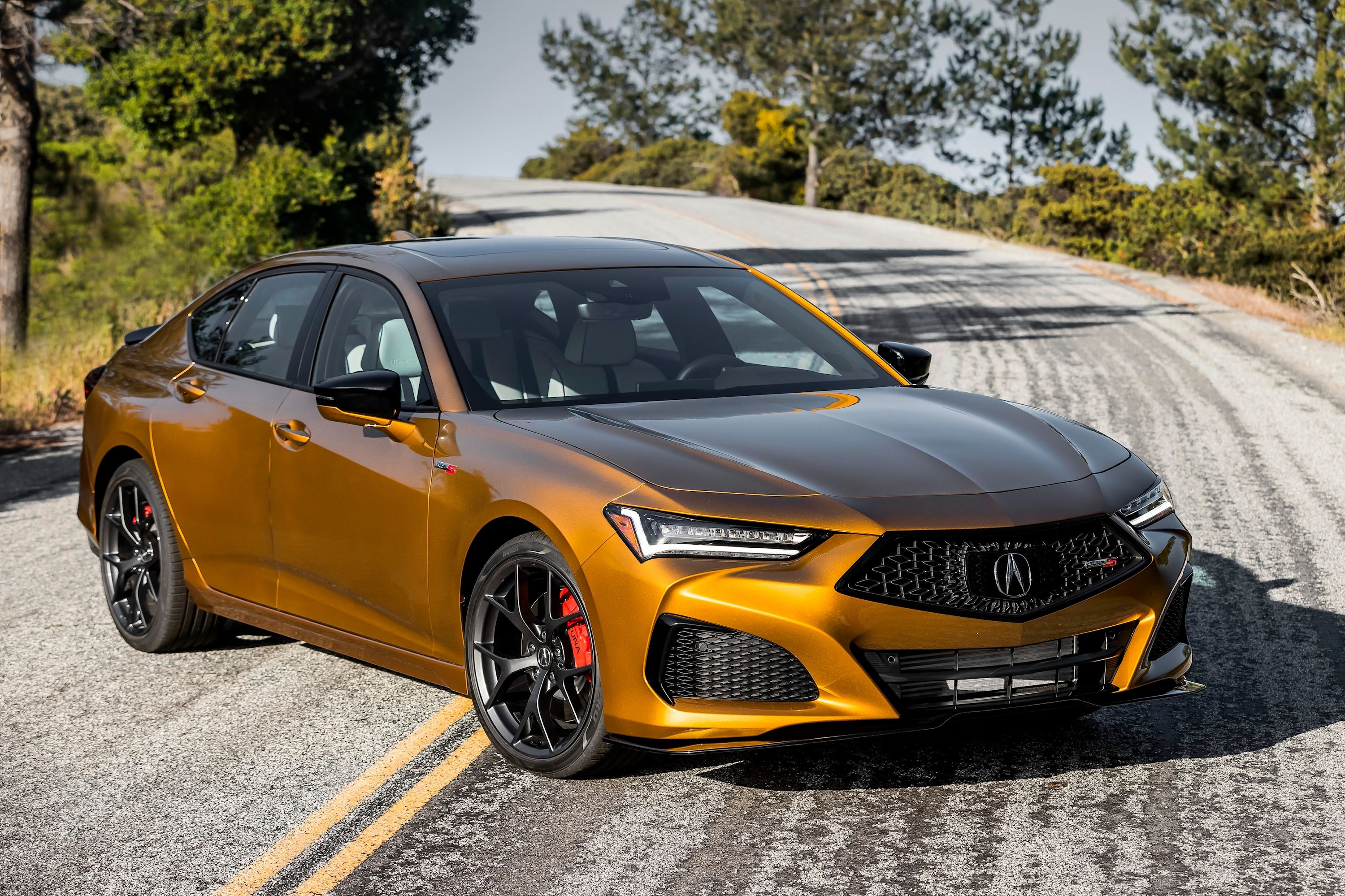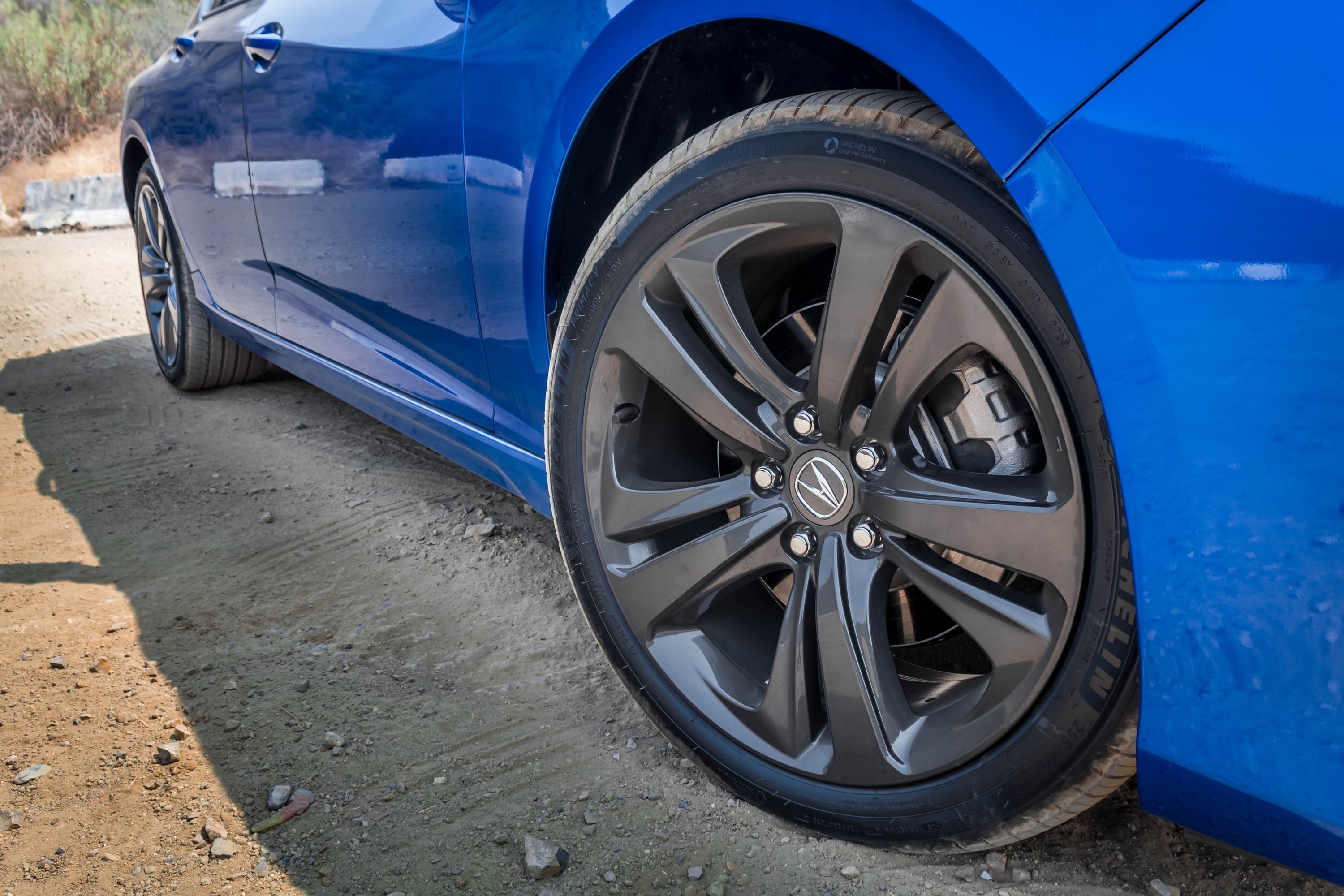
Acura retired the TSX and TL in 2014, replacing them with a single midsize sedan. The TLX arrived as a handsome, comfortable, and competent sedan to straddle the lines between BMW's 3 Series and 5 Series or Audi's A4 and A5. We found the outgoing generation lacked the distinct personality and performance Acura has delivered in the past. Now, after five years of development, the new TLX is set to enter dealerships in the fall, and Acura wants to reclaim its performance image to take a larger bite out of the premium sedan market.
The all-new TLX arrives on Acura's new dedicated platform with a tauter chassis and a more sophisticated suspension system. It also leaves the previous generation's 2.4-liter four-cylinder and optional V6 behind for a 272 horsepower 2.0-liter turbocharged four-cylinder engine. That's connected to Honda's excellent 10-speed transmission and distributes power to all four wheels via Acura's SH-AWD system. The new interior concentrates even harder on comfort and a premium experience to move the TLX further upmarket. It's a recipe that should signify a return to form for Acura, so when we were invited to drive the TLX ahead of its release, we snapped up the chance.
Chassis Design: Letting Passion Take Over
It's no secret that the sedan market has been shrinking, so building a new platform to take on the premium segment's German stalwarts is a bold move right now. Not only has Acura done that, but its engineers and designers have thrown themselves into the project wholeheartedly. Looking at the TLX's technical specs, it's clear that performance and comfort were underlined in red on the design brief.
A new chassis built around an ultra-stiff center tunnel underpins the new TLX. Not only is the new platform lighter and 50 percent more rigid than the previous generation, but weight distribution is improved to give a 57/43 balance between front and rear.
The front suspension is now a double-wishbone design that uses hydraulic bushings to help with compliance while aluminum lower control arms save weight. It's a complex design aiming to increase performance by keeping the body flat in cornering while maintaining tire contact. At the same time, the suspension is designed to be compliant and smooth for daily driving. Progressive reactive dampers are standard, and a full adaptive damper system is also available.
The TLX's braking system has also been redesigned, and Acura has tapped the NSX for its tunable electronic servo brake technology. The steering system is also all-electric with a variable ratio, and it all comes together when you reach the for TLX's mode buttons. Moving from Comfort to Sport mode creates a level of aggression that the previous generation TLX doesn't achieve. It affects the throttle response, the transmission's shift mapping, torque vectoring, the active sound system, and, on models with the optional adaptive suspension, damping. The mode system is also customizable, so the driver can set the parameters to suit their driving style.
Exterior Design: All About Stance And Proportion
In press photos, we liked the new TLX's longer, lower, wider stance and styling, and were not disappointed when seeing it in the metal. At 57 inches tall, 75 inches wide at the back, 73 inches at the front, and with a long, low hood and pronounced rear haunches, it has an aggressive stance and sculpted look. Acura calls it a "near exotic" stance and proportion, and we're not going to argue too hard about that.
The new diamond pentagon grille sits between Acura's new Jewel Eye headlights and LED daytime running lights inspired by the Acura ARX-05 Daytona Prototype. Overall and up close, the new TLX is a sophisticated and elegant looking sedan that gives substance to Acura's claim of moving further upmarket.
Acura's A-Spec appearance package makes a welcome return and will no doubt be a popular choice. It adds plenty of sporty looking features, including Shark Grey 19-inch wheels, gloss black accents, darkened headlight and taillight hardware, and a rear decklid spoiler on the outside. On the inside, red sport seats and red accents combine with real aluminum trim for a sporty yet luxurious feel.
Powertrain: VTEC Isn't Dead
After Honda retired its long-running and popular V6 engine in the Accord, Acura has done likewise for the base TLX. Both the 3.5-liter V6 and 2.4-liter options are replaced by a 2.0-liter direct-injected and turbocharged four-pot engine with VTEC variable timing. While displacement is down, the new engine is no slowpoke and generates 272 hp and 280 lb-ft of torque. That's more powerful than the previous generation's 2.4-liter lump and only just short in horsepower against the 280-hp V6 while making more 13 lb-ft more torque. The 2.0-liter engine also manages to be more fuel-efficient with fuel economy rated at 22/31/25 mpg city/highway/combined.
A 10-speed automatic takes care of shifting duty, offering an extra gear and a wider ratio range over the previous 9-speed transmission, and two more than the 8-speed. The 10-speed also has a lower first gear and will make four-gear direct downshifts. The power from the transmission is distributed to the 4th-generation of Acura's torque-vectoring SH-AWD system that transfers up to 70 percent of engine torque to the rear axle. The torque vectoring system is sophisticated and aims to create sharper and more accurate turn-in while maintaining consistency through corners.
Interior: Turning The Dial Up A Couple Of Notches
Acura describes the new interior as a "personal and tech-focused cabin," and it's a pleasure to climb into. The seating is comfortable, and it's easy to find the perfect driving position. The interior is spacious up front with lots of hip and shoulder room. Simultaneously, sliding into the driver's seat feels like you're entering a cockpit rather than a cabin due to the strong delineation from the passenger's space. Our test models were highly specced, and the materials include premium-feel aluminum and red seats and trim for the A-Spec model and open-pore wood with full-grain Milano leather for the Advanced trim. The steering wheel is a hefty feeling flat-bottom sporty design wrapped in leather and a good clue as to what the car will feel like once it's moving.
There's plenty of careful attention to detail, highlighted by a palm rest for the driver just in front of the center elbow rest. Overall, the interior is stylish, ergonomic, and remarkably comfortable. Added touches like the customizable 24-color ambient lighting system only help to elevate the styling.
Passengers in the rear will find themselves a little cramped, but that's by design to a degree. Rather than building three or four models in a declining market, Acura is limiting its lineup, slotting the TLX somewhere between BMW's 3 Series and 5 Series. The compromise comes in the back seats, but they're perfectly adequate for kids or short journeys with adults. Cargo space is decent, and the seats fold down for those awkward trips to the home-improvement store.
Unfortunately, we can't wax lyrically about the infotainment system. It's based around the awkward True Touchpad Interface, which works better once you figure out it doesn't use a curser like a laptop. Instead, you draw your finger around as if the touchpad is mirroring the screen then press when you find the button you're looking for. The real problem is that the infotainment system as a whole is on the clunky side.
What we can heartily recommend is the optional ELS Studio 3D sound system. It's a 17-speaker system with twin subwoofers that is beautifully designed and tuned to work with the TLX's interior. Acura gave us USB sticks with high-quality sound files, which, as expected, sounded amazing. However, most people won't go full audiophile in the car, so we hooked up Spotify by Bluetooth to see how highly compressed streaming files played. It still sounded fantastic, and the ELS Studio 3D takes its place amongst the best audio systems available from the factory.
On The Road: Razor Blade Sharp
Acura has dedicated itself to a return to form with performance, and it shows. We got to take the TLX out onto the roads around the Santa Monica Mountains and onto the Pacific Coast Highway. Within a mile, we were on a tight and twisty road, and immediately the TLX felt at home carving through corners with a sharpness beyond expectation. Punching Sport mode dramatically changes the car, speeding up response and putting a real edge on the steering. There's clearly a lot of sophisticated technology at work under the body. However, the result is an engaging car that turns in on a dime and hangs on through the corner without feeling like it's on autopilot. The steering feel is pleasing, but the real communication is between the chassis and the driver's body.
Changes in direction are just as quick as initial turn in, and the weakness comes in the all-weather tires. The Michelin Primacy tires on the test cars audibly protested when pushed a little, although they are an excellent choice for balancing comfort and all-weather performance. Saying that, even without grippier summer tires, the TLX still doesn't give in to understeer unless provoked, and the shifting torque keeps the TLX feeling like a rear-wheel-drive car where it counts.
Dropping out of Sport mode and onto the Pacific Coast Highway, the TLX settled into its other role as a compliant cruiser. Despite the added rigidity in the chassis and firmness in the damping, bumps and occasional potholes are soaked up with little drama. The 10-speed transmission is a great one, and once wound down becomes smooth enough that you forget its working with all those cogs. In fact, the transmission does a lot of work as while the power specs for the engine are impressive for a four-cylinder engine, the TLX is no traffic light Grand Prix racer.
There's power enough to enjoy the car, and it competes with the German base models, but those looking for a grin-inducing shove of acceleration will want to wait for the Type S and its freshly developed 3.0-liter turbocharged V6 engine.
Verdict: Acura Has Delivered A Driver's Car
With the new TLX, Acura is targeting customers that would otherwise be looking at base model BMW, Audi, and Mercedes cars. Pricing for the TLX is aggressive, starting at $37,500, and delivers standard features customers would have to add as options on base model European cars. It's a tactic that has been tried before, but the TLX has a trick up its sleeve: It's also squarely aimed at people that love to drive.
We were genuinely impressed at the car's handling and grip with the tires provided. More importantly, it was a lot of fun to drive on curvy roads, and then in cruise mode, it became a comfortable and well-behaved premium sedan comparable to its German rivals.
We're looking forward to getting a full week to get to know the new TLX properly. However, we've got a feeling people cross-shopping for an entry-level luxury sedan are going to be extremely tempted by the new TLX and everything it has to offer. On top of that, fans of older Acura cars aimed at enthusiasts will enjoy the upgrade and what's shaping up to be a return to form.

